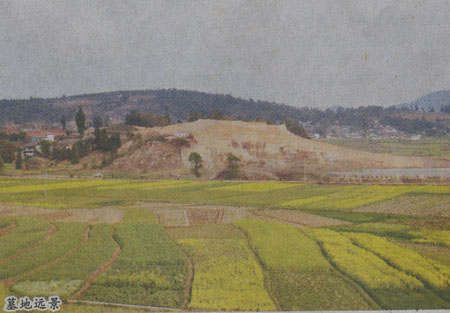Peculiar Cave-chamber Tombs Found in Dadianshan Cemetery, Yunnan
From:Chinese Archaeology NetWriter:Date:2014-04-02
Salvage excavation of Dadianshan cemetery, which is located at Tianyuan Town, Changning County, has been jointly carried out by Yunnan Provincial Institute of Cultural Relics and Archaeology, Baoshan Museum and Baoshan Cultural Relics Administration in March 2013. The cemetery, 3km northwest from Changning county seat, has an altitude of 1634 m. The uncovered area is more than 2500 square meters. 198 tombs of a large variety of types are cleared along with 268 funeral gifts.
Among the 198 tombs cleared in the cemetery, there are three kinds being recognized according to their shapes and structures. Specifically, 179 shaft earthen pit tombs, 18 earthen cave-chamber tombs as well as 1 urn burial are discovered.
Shaft earthen pit tombs are directly dug in gravel soils and mostly filled by earth containing gravels and stones. Tombs of this kind are mainly small tombs with a slightly shallow pit and no burial gifts in most cases, often covering 1-3 square meters. Only 36 tombs have funeral goods and the majority of them are small ones, such as small pottery wares with ears, stone pendants, spinning wheel and etc..

overview of the cemetery
18 earthen cave-chamber tombs are very peculiar tomb form in the excavation of Dadianshan cemetery. Distributed over the south slope and the top of the hill, they are at the center of the cemetery. All of the tombs are dug in the plaster with a relatively small opening, long narrow pit and a sloping bottom. The tombs are often 3-4 meter long. The skeletons are already rotten. Only remains of bones and tooth can be recognized in few tombs. Some coffins are carbonized. Earthen cave-chamber tombs all have a vertical cave without a passage. The tops of tombs are curved or obliquely flat. The tombs cover very limited areas. Original graves constructed in the plaster become smaller and narrower gradually because of the squeeze, deformation and sinking of plaster caused by meeting water. Funeral artifacts are fairly abundant. The richest tomb has 26 artifacts. The majority of burial gifts are bronze artifacts including all kinds of weapons, such as cutlasses, arrowheads, battle-axes and so on. No pottery is unearthed at all.
Only one urn burial is found in the southeast corner of the cemetery. The grave is round in plane with straight walls and a flat bottom. The urn is sand-tempered grayish brown pottery decorated with code pattern on the body surface.
Burial gifts contain stone artifacts, pottery wares, copper artifacts, copper and iron alloy products, iron wares, amber, seashells, hemp fabrics, bamboo and rattan ( which are heavily carbonized and left behind ) and etc.. Copper artifacts are the majority.
Among copper items, the numbers of cutlasses (including cutlasses with human face design), arrowheads, Chuan-bangles, battle-axe, swords are more than those of others, such as buckles, bracelets, He-cases, finger guards, Dun-instruments (parts of weapons), axes, chisels, bullhorns, ivories, covers, holders, collars with bells, bells, brass rings and the like. Remarkably, the discovery of copper cutlasses (including the ones with human face design), boot-shaped battle-axes, Chuan-bangles, He-cases, finger guards, bullhorns, ivories and so on are the first appearance in Yunnan Province and even the Southwest region. They are quite unique.

unearthed artifacts from the cemetery
Stone artifacts include pendants, moulds, spinning wheels, adzes as well as turquoise and so on. Ceramic artifacts have cups with single ear, Guan-jars, clay spinning wheels and etc.. The alloys of copper and iron contain iron arrowheads with copper handles and copper arrowheads with iron handles and the like. Iron artifacts range from arrowheads, filings, swords, Chuan-bangles and etc.. Amber beads discovered exclusively in earthen cave-chamber tombs are reddish-brown and oblong tube beads with a length of 1.8-3.2 cm and an inner diameter of 0.2-0.4 cm. The number of amber beads from one tomb can vary from tens to hundreds. What’s more, seashells, rattan and bamboo made leg sleeves and so on are found, too.
The earthen cave-chamber tombs excavated in Dadianshan cemetery are the first discovery of this unique kind of tombs in Yunnan Province and even the whole Southwest region. Their structures are different from those discovered in North China in terms of their plaster breaking graves, sloping bottoms as well as relatively low positions of funeral gifts. The fills of graves contain lots of plaster. The unearthed artifacts are all bronze items without single piece of pottery. In this case, the principal part of grave masters buried in earthen cave-chamber tombs is presumed to be related to Baipu people who lived in the middle reach of Yangtze River at that time. While shaft earthen pit tombs dug in gravel soil bear a close relationship with stones. A small amount of artifacts are discovered in them, only including different kinds of ceramic wares with ears. Therefore, this kind of tombs may be remains of Di and Qiang people from Northwest China. (Translator: Ma Huanhuan)

